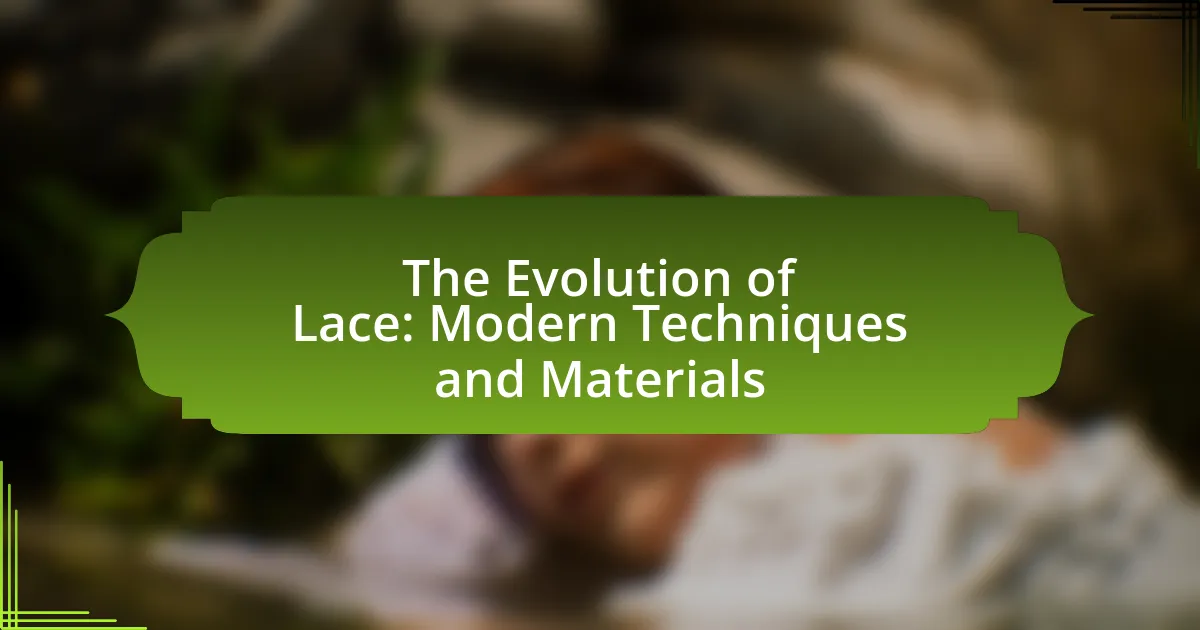The article focuses on the evolution of lace, tracing its origins from the late 15th century in Europe to its modern applications. It highlights the transition from hand-made to machine-made lace during the Industrial Revolution, which increased accessibility and variety. Key cultural influences, technological advancements, and the emergence of different lace types are discussed, along with the impact of synthetic materials and modern techniques on lace production. The article also explores contemporary uses of lace in fashion and interior design, emphasizing best practices for working with modern lace materials and maintenance tips.

What is the history of lace and its evolution?
Lace originated in the late 15th century in Europe, evolving from techniques used in embroidery and netting. Initially, lace was hand-made using threads of linen, silk, or gold, and it became a symbol of wealth and status among the aristocracy. By the 16th century, lace-making techniques spread across Italy, France, and Belgium, leading to the development of various styles such as Venetian lace and Flemish lace. The Industrial Revolution in the 19th century introduced machine-made lace, significantly increasing production speed and accessibility. This transition marked a shift from exclusive hand-crafted pieces to mass-produced lace, making it available to a broader audience. Today, lace continues to evolve with modern techniques and materials, incorporating synthetic fibers and innovative designs while maintaining its historical significance in fashion and textiles.
How did lace originate and develop over time?
Lace originated in the late Middle Ages, evolving from the decorative techniques of embroidery and netting. Initially, lace was created by hand, using techniques such as needle lace and bobbin lace, which became prominent in the 16th century in Italy and later spread to France and England. The development of lace continued through the Renaissance, where it became a symbol of wealth and status, leading to intricate designs and the use of finer materials. By the 19th century, the introduction of mechanized lace-making machines in the Industrial Revolution allowed for mass production, significantly increasing accessibility and variety. This evolution reflects a transition from artisanal craftsmanship to industrial manufacturing, shaping lace into a versatile textile used in fashion and home decor today.
What cultural influences shaped the early forms of lace?
The early forms of lace were shaped by various cultural influences, primarily from Italy, France, and Flanders. Italian artisans in the 15th century developed needle lace, which emphasized intricate designs and fine craftsmanship, reflecting the Renaissance’s artistic values. In France, lace-making became a symbol of luxury and status during the 17th century, particularly with the introduction of bobbin lace, which allowed for more complex patterns and was often used in royal garments. Flanders contributed significantly through its production of lace, which was exported widely and influenced styles across Europe. The combination of these regional techniques and cultural values established the foundational styles of lace that evolved over time.
How did technological advancements impact lace production?
Technological advancements significantly transformed lace production by introducing mechanized processes that increased efficiency and reduced labor costs. The invention of the Jacquard loom in the early 19th century allowed for intricate patterns to be woven automatically, which previously required skilled artisans to create by hand. This innovation led to mass production of lace, making it more accessible and affordable. Additionally, the development of synthetic fibers in the 20th century further revolutionized lace production by providing durable and cost-effective materials, expanding design possibilities and market reach.
What are the different types of lace throughout history?
Throughout history, various types of lace have emerged, each characterized by unique techniques and cultural significance. Notable types include Venetian lace, known for its intricate designs and use of needle lace techniques; Chantilly lace, recognized for its fine, delicate patterns and often used in fashion; and Bobbin lace, which involves weaving threads around pins on a cushion, prevalent in regions like Belgium and England. Additionally, Cluny lace, originating from France, features a heavier, more textured appearance, while Guipure lace, made from embroidered motifs connected by bars or plaits, showcases a distinct style. Each type reflects the craftsmanship and aesthetic preferences of its time, contributing to the rich tapestry of lace history.
What distinguishes handmade lace from machine-made lace?
Handmade lace is distinguished from machine-made lace primarily by its intricate craftsmanship and unique patterns. Handmade lace is created through manual techniques such as tatting, crocheting, or needle lace, which allows for greater artistic expression and variability in design. In contrast, machine-made lace is produced using automated processes that replicate patterns quickly and uniformly, resulting in less variation and often a more rigid appearance. The historical context of lace-making reveals that handmade lace has been valued for its labor-intensive creation, often taking hours or days to complete a single piece, whereas machine-made lace can be manufactured in a fraction of that time, leading to differences in quality and price.
How have styles of lace changed in various fashion eras?
Styles of lace have evolved significantly across various fashion eras, reflecting changes in technology, aesthetics, and cultural influences. In the 16th century, lace was primarily handmade, featuring intricate designs and was often used as a status symbol among the wealthy. The 19th century saw the introduction of machine-made lace, which made it more accessible and led to simpler, more uniform patterns. By the early 20th century, lace became a staple in women’s fashion, often incorporated into garments like dresses and blouses, showcasing delicate floral motifs. In contemporary fashion, lace has diversified further, with designers experimenting with bold colors, textures, and innovative materials, such as synthetic fibers, allowing for greater versatility and creativity in its application. This progression illustrates how lace has transitioned from a luxury item to a widely used fabric in modern fashion, adapting to the tastes and technologies of each era.

What modern techniques are used in lace-making today?
Modern lace-making techniques include machine lace production, digital embroidery, and the use of laser cutting technology. Machine lace production allows for high-speed manufacturing and intricate designs, significantly increasing efficiency compared to traditional hand-made methods. Digital embroidery utilizes computer software to create precise patterns, enabling customization and rapid production. Laser cutting technology offers the ability to cut lace patterns with high accuracy, reducing material waste and enhancing design possibilities. These techniques reflect advancements in technology that have transformed lace-making into a more efficient and versatile craft.
How has technology transformed traditional lace-making methods?
Technology has significantly transformed traditional lace-making methods by introducing automated machinery and digital design tools. Automated lace-making machines, such as Jacquard looms, have increased production speed and precision, allowing for intricate patterns that were previously labor-intensive and time-consuming to create by hand. Additionally, computer-aided design (CAD) software enables designers to visualize and modify lace patterns digitally, streamlining the design process and enhancing creativity. This shift from manual techniques to technology-driven methods has not only improved efficiency but also expanded the accessibility and variety of lace products available in the market.
What role do digital tools play in contemporary lace design?
Digital tools play a crucial role in contemporary lace design by enabling designers to create intricate patterns and structures with precision and efficiency. These tools, such as computer-aided design (CAD) software, allow for the manipulation of designs in a digital space, facilitating experimentation with various motifs and textures that would be challenging to achieve manually. Additionally, digital tools streamline the production process, allowing for rapid prototyping and adjustments, which enhances creativity and reduces time-to-market for new designs. The integration of digital embroidery machines further exemplifies this impact, as they can execute complex lace designs with high accuracy, thus transforming traditional lace-making techniques into modern practices that leverage technology for innovation.
How do modern lace-making techniques compare to historical methods?
Modern lace-making techniques utilize advanced technology and synthetic materials, contrasting with historical methods that relied on manual craftsmanship and natural fibers. Historically, lace was predominantly hand-made using techniques such as needle lace and bobbin lace, which required significant time and skill. In contrast, contemporary methods often incorporate machine-made lace, allowing for mass production and intricate designs at a faster pace. For instance, the introduction of computerized embroidery machines has revolutionized lace production, enabling precise patterns that would be labor-intensive to create by hand. This shift not only enhances efficiency but also expands design possibilities, reflecting a significant evolution in the art of lace-making.
What innovative materials are being used in modern lace production?
Modern lace production utilizes innovative materials such as synthetic fibers, including nylon and polyester, which offer durability and versatility. These materials allow for intricate designs and patterns that were previously difficult to achieve with traditional cotton or silk. Additionally, advancements in technology have introduced 3D printing and laser-cutting techniques, enabling the creation of lace with complex geometries and customized designs. The use of eco-friendly materials, such as recycled fibers and biodegradable options, is also gaining traction, reflecting a growing trend towards sustainability in textile production.
How do synthetic fibers enhance the properties of lace?
Synthetic fibers enhance the properties of lace by providing increased durability, elasticity, and resistance to environmental factors. These fibers, such as polyester and nylon, are stronger than traditional materials like cotton or silk, allowing lace to maintain its shape and structure over time. Additionally, synthetic fibers are less prone to fading and shrinking, which ensures that the intricate designs of lace remain vibrant and intact after multiple washes. This combination of strength and resilience makes synthetic lace suitable for a wider range of applications, from fashion to home decor, thereby expanding its usability and appeal.
What are the environmental impacts of modern lace materials?
Modern lace materials, particularly those made from synthetic fibers, have significant environmental impacts, including high energy consumption during production and non-biodegradability. The manufacturing process for synthetic lace often involves petroleum-based materials, which contribute to greenhouse gas emissions and pollution. Additionally, the disposal of synthetic lace contributes to plastic waste in landfills and oceans, where it can take hundreds of years to decompose. Studies indicate that the textile industry, including lace production, is responsible for approximately 10% of global carbon emissions, highlighting the urgent need for sustainable alternatives.

What are the applications of modern lace in various industries?
Modern lace has diverse applications across various industries, including fashion, interior design, and technology. In the fashion industry, lace is used in garments such as dresses, blouses, and lingerie, enhancing aesthetics with intricate designs. The interior design sector employs lace for decorative elements like curtains, tablecloths, and upholstery, adding elegance to spaces. Additionally, the technology industry utilizes lace in the production of advanced textiles, such as smart fabrics that incorporate sensors for health monitoring. These applications demonstrate lace’s versatility and its ability to blend traditional craftsmanship with modern innovation.
How is lace utilized in fashion and apparel today?
Lace is utilized in fashion and apparel today primarily as a decorative element that adds texture and elegance to garments. Designers incorporate lace into various clothing items, including dresses, blouses, and lingerie, often using it to create intricate patterns and layers that enhance visual appeal. For instance, lace overlays are commonly seen in evening wear, where they provide a sophisticated touch, while lace trims are frequently used on casual wear to elevate everyday outfits. The versatility of lace allows it to be combined with modern materials like polyester and nylon, which enhance durability and ease of care, making it suitable for a wider range of fashion applications.
What trends are emerging in lace fashion design?
Emerging trends in lace fashion design include the use of sustainable materials, innovative techniques such as 3D printing, and the integration of technology like smart textiles. Sustainable materials, such as organic cotton and recycled fibers, are gaining popularity as consumers increasingly prioritize eco-friendly fashion. Innovative techniques, particularly 3D printing, allow for intricate lace patterns that were previously difficult to achieve, enhancing design possibilities. Additionally, smart textiles are being incorporated into lace designs, enabling features like temperature regulation and moisture-wicking properties, which cater to modern consumer needs. These trends reflect a shift towards sustainability, technological advancement, and versatility in lace fashion.
How do designers incorporate lace into contemporary collections?
Designers incorporate lace into contemporary collections by utilizing innovative techniques and diverse materials to create unique textures and patterns. For instance, they often blend traditional lace with modern fabrics like neoprene or mesh, enhancing the structural integrity and versatility of the garments. Additionally, designers may employ digital printing methods to produce intricate lace designs, allowing for customization and a broader range of applications. This approach not only preserves the aesthetic appeal of lace but also adapts it to current fashion trends, making it relevant in today’s market.
What role does lace play in home decor and interior design?
Lace serves as a decorative element in home decor and interior design, adding texture, elegance, and a sense of softness to various spaces. Its intricate patterns can enhance the aesthetic appeal of curtains, tablecloths, and upholstery, creating a visually engaging environment. Historically, lace has been associated with luxury and craftsmanship, often used in high-end designs to convey sophistication. The use of modern techniques and materials has expanded lace’s versatility, allowing it to be incorporated into contemporary designs while maintaining its traditional charm.
How can lace be used to enhance aesthetic appeal in interiors?
Lace can enhance aesthetic appeal in interiors by adding texture, elegance, and a sense of delicacy to various design elements. The intricate patterns and lightweight nature of lace allow it to be used in curtains, tablecloths, and decorative accents, creating a visually appealing contrast with solid surfaces. For instance, lace curtains can soften natural light while providing privacy, and lace table runners can elevate the sophistication of dining settings. Historical usage of lace in interior design dates back to the 16th century, where it was employed in royal households, demonstrating its long-standing association with luxury and refinement.
What are some best practices for working with modern lace materials?
Best practices for working with modern lace materials include using the appropriate needle and thread to prevent damage, ensuring proper tension during stitching to maintain the integrity of the lace, and pre-washing the lace to remove any sizing or chemicals that may affect the final product. Additionally, it is essential to use a stabilizer when embroidering on lace to prevent distortion, and to handle lace gently to avoid fraying or tearing. These practices are supported by industry standards that emphasize the importance of careful handling and preparation to achieve high-quality results in lacework.
How can one care for and maintain lace products effectively?
To care for and maintain lace products effectively, one should hand wash them in cold water using a mild detergent specifically designed for delicate fabrics. This method prevents damage to the intricate fibers and maintains the lace’s appearance. Additionally, it is essential to avoid wringing or twisting the lace; instead, gently press out excess water and lay the lace flat on a clean, dry towel to air dry. This drying technique helps preserve the shape and prevents stretching. Regularly inspecting lace for any signs of wear or damage allows for timely repairs, ensuring longevity.
What tips can help in selecting the right lace for projects?
To select the right lace for projects, consider the project’s purpose, fabric compatibility, and desired aesthetic. The purpose dictates the lace type; for example, lightweight lace suits delicate garments, while heavier lace works for structured pieces. Compatibility with the main fabric is crucial; lace should complement rather than overpower the base material. Additionally, the aesthetic should align with the project’s theme, whether vintage, modern, or romantic. Research indicates that the right lace enhances the overall design, as seen in fashion collections where lace choice significantly impacts the garment’s appeal.



